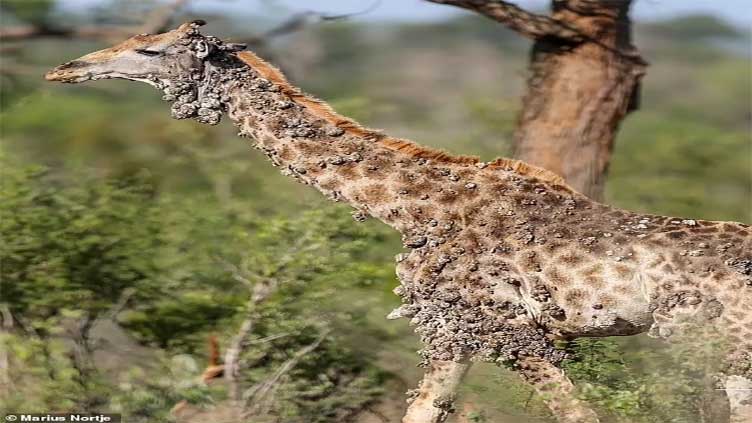Viral disease: Photos show giraffe covered with hundreds of skin lesions

WeirdNews
The unfortunate creature was spotted in Kruger National Park, South Africa
(Web Desk) - Heartbreaking new photos reveal a 'bumpy' giraffe covered with hundreds of skin lesions due to a rare viral disease.
The unfortunate creature was spotted in Kruger National Park, South Africa by wildlife photographer Marius Nortje.
According to experts, the painful-looking lumps could be caused by a form of papillomavirus spread through infected blood.
This family of diseases also infect humans in the form of human papillomavirus (HPV) which is an extremely common sexually transmitted infection.
Gemma Campling, head veterinarian and CEO of Worldwide Vets who first shared the pictures, told MailOnline: 'New lesions begin as a thickened plaque on the skin. The lumps grow and rupture, leaving an ulcerated scab.'
Although not particularly dangerous by themselves, in severe cases these lesions can hinder an animal's movement and feeding, or lead to fatal secondary infections.
Ms Campling adds: 'However, there is a silver lining: the tumour does not appear to be interfering with the animal’s ability to feed or see.'
'This means the giraffe is likely to live out a normal lifespan despite its condition.'
In humans, papillomavirus causes genital warts, but Ms Campling says that this giraffe is likely infected with a different variety called bovine papillomavirus (BVP).
She says: 'Recent research has shown similar “lumpy giraffes” in South Africa do carry the papillomavirus that should only be affecting cows, and deer.'
In 2007, researchers from the University of Pretoria found two giraffes which appeared to be infected with BVP in the Kruger National Park.
The animals were euthanised by rangers to prevent the virus from spreading further and genetic analysis of their tumours showed that BVP was indeed present.
'So, in these photos we are seeing an example of viral mutation and the virus affecting giraffes for the first time,' Ms Campling says.
She adds that we don't know whether the disease will mutate further to jump to other animals.
BVP typically spreads through infected blood entering cuts on the skin, which means it requires close physical contact to spread.
Ms Campling says: 'Since giraffes don’t have much direct physical contact with one another, it is likely that giraffes are rubbing on inanimate objects, like trees, and that is allowing spread.'


